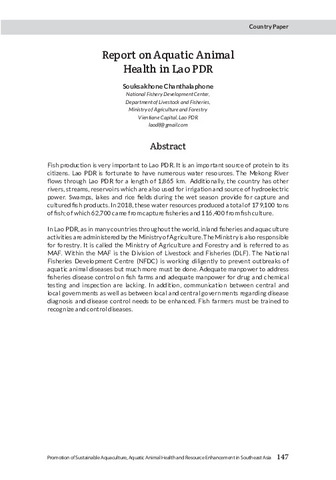Report on aquatic animal health in Lao PDR
| dc.contributor.author | Chanthalaphone, Souksakhone | |
| dc.contributor.editor | Aya, Frolan A. | |
| dc.contributor.editor | de la Peña, Leobert D. | |
| dc.contributor.editor | Salayo, Nerissa D. | |
| dc.contributor.editor | Tendencia, Eleonor A. | |
| dc.date.accessioned | 2021-12-16T02:32:08Z | |
| dc.date.available | 2021-12-16T02:32:08Z | |
| dc.date.issued | 2021-12 | |
| dc.identifier.citation | Chanthalaphone, S. (2021). Report on aquatic animal health in Lao PDR. In F. A. Aya, L. D. de la Peña, N. D. Salayo, & E. A. Tendencia (Eds.), Proceedings of the International Workshop on the Promotion of Sustainable Aquaculture, Aquatic Animal Health, and Resource Enhancement in Southeast Asia (p. 147). Tigbauan, Iloilo, Philippines: Aquaculture Department, Southeast Asian Fisheries Development Center. | en |
| dc.identifier.isbn | 9789719931102 (Print) | |
| dc.identifier.isbn | 9789719931119 (PDF) | |
| dc.identifier.uri | http://hdl.handle.net/10862/6266 | |
| dc.description | Abstract only. | en |
| dc.description.abstract | Fish production is very important to Lao PDR. It is an important source of protein to its citizens. Lao PDR is fortunate to have numerous water resources. The Mekong River flows through Lao PDR for a length of 1,865 km. Additionally, the country has other rivers, streams, reservoirs which are also used for irrigation and source of hydroelectric power. Swamps, lakes and rice fields during the wet season provide for capture and cultured fish products. In 2018, these water resources produced a total of 179,100 tons of fish; of which 62,700 came from capture fisheries and 116,400 from fish culture. In Lao PDR, as in many countries throughout the world, inland fisheries and aquaculture activities are administered by the Ministry of Agriculture. The Ministry is also responsible for forestry. It is called the Ministry of Agriculture and Forestry and is referred to as MAF. Within the MAF is the Division of Livestock and Fisheries (DLF). The National Fisheries Development Centre (NFDC) is working diligently to prevent outbreaks of aquatic animal diseases but much more must be done. Adequate manpower to address fisheries disease control on fish farms and adequate manpower for drug and chemical testing and inspection are lacking. In addition, communication between central and local governments as well as between local and central governments regarding disease diagnosis and disease control needs to be enhanced. Fish farmers must be trained to recognize and control diseases. | en |
| dc.language.iso | en | en |
| dc.publisher | Aquaculture Department, Southeast Asian Fisheries Development Center | en |
| dc.rights | Attribution-NonCommercial-ShareAlike 3.0 IGO | * |
| dc.rights.uri | http://creativecommons.org/licenses/by-nc-sa/3.0/igo/ | * |
| dc.subject | Lao People's Democratic Republic | en |
| dc.subject | fishery production | en |
| dc.title | Report on aquatic animal health in Lao PDR | en |
| dc.type | Conference paper | en |
| dc.citation.spage | 147 | |
| dc.citation.conferenceTitle | Proceedings of the International Workshop on the Promotion of Sustainable Aquaculture, Aquatic Animal Health, and Resource Enhancement in Southeast Asia | en |
| dc.subject.asfa | aquatic organisms | en |
| dc.subject.asfa | health | en |
| dc.subject.asfa | inland fisheries | en |
| dc.subject.asfa | aquaculture | en |
| dc.subject.asfa | animal diseases | en |
Files in this item
This item appears in the following Collection(s)
-
Promotion of Sustainable Aquaculture, Aquatic Animal Health, and Resource Enhancement in Southeast Asia (SARSEA) [31]
Proceedings of the International Workshop on the Promotion of Sustainable Aquaculture, Aquatic Animal Health, and Resource Enhancement in Southeast Asia 25–27 June 2019, Iloilo City, Philippines



